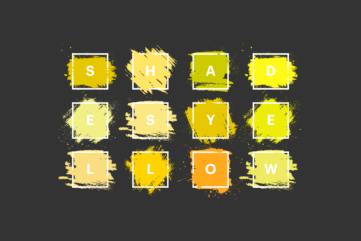What does purple signify in branding? An introduction to purple brands

What does purple signify in branding, and why do designers use purple to create logos and websites?
Purple is a somewhat unusual color, capable of conveying a wide range of emotions and ideas. The diversity of the shade, created by combining red and blue, means business leaders can use purple to symbolize everything from bravery and individuality to compassion and creativity.
Color psychology shows us that every hue has a distinct impact on our thoughts and feelings. We commonly associate red with confidence, passion, and strength. Blue, the world’s most popular color, is often connected to concepts like tranquillity, trust, and reliability.
When we combine these two shades, we get an entirely different color, capable of eliciting its own unique responses. Like with most colors, the impact purple has on an audience will depend on several factors, including its tone, shade, and weight.
Today, we’ll take a closer look at purple’s meaning in the branding world and how you can determine whether this shade is right for you.
Why do designers use purple? Understanding purple brands
Compared to other well-known colors like green, blue, and red, purple is a less common color in branding. This shade is quite controversial, and studies have shown people are more likely to dislike the color purple than most other hues.
Specifically, men commonly chose purple as their least favorite color. Of course, this doesn’t make the shade “bad” for branding. Companies need to consider their target audience carefully when choosing their palette.
While purple in branding can have many different meanings, it’s most commonly associated with concepts like luxury and royalty.
Historically, purple was a far more expensive and inaccessible color for dyes many centuries ago. This meant only nobility and wealthier individuals were able to wear purple. Although the color is far more available today, it still strongly connects with indulgence and the aristocracy.
Because of this, some people will see purple as a sign of something rich, exclusive, or unique. However, others may see the color as arrogant. Outside of associations with luxury, the color purple is also connected to various other ideas.
Some experts believe it stimulates the part of the brain associated with creativity because purple is less common in nature than other shades.
What does purple symbolize for a brand?
The impact of purple in branding depends heavily on the tone used. Softer shades of purple, like lilac and lavender, are frequently linked to femininity, compassion, and affinity. Alternatively, darker colors are commonly connected with power, mystery, and wisdom.
Let’s take a closer look at the symbolism behind some purple brands.
Purple brand symbolism: Women and femininity
Some brand designers use the color purple to connect with a more female audience. This is because, scientifically, women tend to like purple more than men. There’s also a strong connection between purple and various female movements.
The Women’s Libertarian Movement, the Women’s Social and Political Movement, and many other groups have leveraged purple to symbolize power and independence.

Even International Women’s Day, a date associated with female liberation, has a logo depicted exclusively in purple. According to the head of the IWD organization, purple has long been associated with efforts connected to the fight for gender equality.
Purple in branding: Luxury and royalty
As mentioned above, purple in branding is most commonly connected with luxury. This is because the color purple appears exceedingly rare in nature and hasn’t always been easy to access.
Some of the earliest purple dyes date back to 1900 BC when experts needed to extract pigment from up to 10,000 shellfish just to dye a Roman toga.
This specific brand of purple dye was worth more than its weight in gold, making it the number one choice of kings, emperors, and queens keen to demonstrate their status. The color purple has maintained its link to luxury, royalty, and excellence over the years.
Even Queen Elizabeth wore a purple robe for her coronation.

Today, groups like the Premier League use the color purple combined with the image of a lion wearing a crown to highlight the premium nature of the league.
Purple logos: Spirituality and the supernatural
Given the rarity of the color purple in nature, the shade has also come to represent spiritual concepts and the supernatural. The shade appears regularly in religion. In Hinduism, purple is usually associated with wisdom and peace. In Judaism, it’s connected to redemption.
On a broader scale, purple is frequently connected to the unknown, which may be why certain brands use it to convey a sense of mystery. The Cable Network Syfy, which focuses on broadcasting paranormal, fantasy-based, and science-fiction programming, chose purple for its logo.

Various books, movies, and television shows have also implemented purple into their branding to capture their customers’ curiosity.
Purple branding for creativity and imagination
As mentioned above, purple is well-known for activating the part of our brains most associated with innovation and creativity. We see purple as enlightening and inspiring because it’s such an unusual shade to see in the natural world.
Many technology companies have embraced purple as a way of showing their followers their ability to think outside of the box. The Viber logo is depicted in purple to highlight innovation, similar to the Twitch logo, which is frequently connected with creativity and creation in general.

The electronics company BenQ uses a deep shade of purple to combine ideas of sophistication and excellence with imagination and discovery.
Deeper shades of purple can also be an excellent way to convey ideas like “wisdom.” This might be why many universities and learning institutions use the color purple in their brand marks.
Purple symbolism: Compassion and communication
While colors like pink are often associated with romance, red is connected with passion; purple is more commonly connected to ideas like friendship, inclusion, and affinity.
The shade frequently refers to concepts like compassion when used in lighter tones. Bright and rich shades of purple can symbolize communication and collaboration.
Many organizations have leveraged purple to convey ideas connected to relationships. Microsoft Teams, for instance, has multiple shades of purple in its logo.

Discord, a brand best known for connecting communities of gamers and online artists, also has a bright purple logo, ideal for showcasing concepts like youth and vitality.
Notably, while many associate purple with positive emotions, it’s also been linked to ideas like frustration and confusion, particularly in darker shades.
Purple and the concept of courage
In certain parts of the world, purple can have distinct meanings. For instance, the purple heart is among the most prestigious awards available to military members in the United States. It’s a sign of courage and excellence in war.
As such, many people have grown to associate the shade with bravery and accomplishment.
This may be one of the reasons why technology companies use purple in branding, to showcase their confidence as they pursue new environments and ideas.

Purple can also be a way of showcasing excellence. For instance, the Wimbledon logo uses shades of both purple and green to highlight the grass pitches on which players compete and the sophisticated nature of the championship.
Is purple a good color to use for branding?
Should you consider using purple in branding?
There’s no one-size-fits-all strategy for using the right color in your branding elements. Different colors can evoke different feelings depending on their tone, where you are in the world, and various other factors.
Purple is a highly versatile color that can help differentiate a brand. Because it’s less common in the branding world, it’s more likely to stand out than some other shades.
A dark shade of purple could give a brand a hint of mystery and spirituality. A brighter shade may convey community and inclusion, while light shades symbolize compassion.
As with all branding strategies, it’s essential to think carefully about the nature of your target audience before you dive into choosing your color palette.
While purple could have incredible benefits to offer brands in the right circumstances, it’s also a somewhat controversial color that will appeal to only some.
Fabrik: A branding agency for our times.
Now read these:
—What does purple mean in marketing?
—Should you use purple in packaging design?
—Is purple a good color for logo design?
—Understanding the psychology of purple
—Why is purple associated with royalty?
—A guide to colors that complement purple
—Definitive guide to the shades of purple
—Popular companies with purple logos
—Your guide to which colors make purple
—Exploring the colors of the rainbow
















